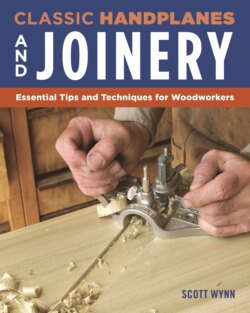Читать книгу Classic Handplanes and Joinery - Scott Wynn - Страница 13
На сайте Литреса книга снята с продажи.
The Ideal Edge
ОглавлениеThe edge requirements for cutting different materials vary widely. The most obvious example is the edge required on a kitchen knife. Meat and vegetables are cut by the sawing action of drawing a coarse edge through them. A properly sharpened kitchen knife has what under a microscope would look like a series of small saw teeth, which result from sharpening it with an 800- or 1,200-grit stone. If you are skeptical, sharpen your best kitchen knife like a plane blade with a #8000 stone and try to cut a potato. It will stop cutting halfway through and jam: the knife is sharp enough to cut transparent shavings in wood, but it will not cut halfway through a root vegetable.
Shaving is another one: a razor is somewhat coarsely sharpened so its edge is a series of fine teeth. These “teeth” are then polished with a very fine stone and strop. The teeth snag the hairs and the polish on the teeth allows them to cut the hair. It should be sharper for good woodworking. The lesson is that demonstrations of sharpness using other materials and claims of qualities originating in other trades and uses, such as industry or surgery, are not particularly useful in evaluating a woodworking blade.
Conceptually, for a blade to be perfect for woodworking, it must be possible to polish it down to single-crystal uniformity across its entire edge, with the crystals all lined up neatly, oriented the same direction, all very small and of the same size, equally hard, and tightly bonded to one another so they will not break off. In reality, several types of crystals comprise a cutting edge. The crystals are greatly different in size and hardness and grouped together so they present themselves at the cutting edge in clusters, and so tend to break off in clusters, leaving voids and dull spots. The finest blades, however, have the qualities that enable something approaching the ideal edge.
The techniques used in preparing steel for woodworking tools are hammer forging, drop forging, and no forging. Hammer forging, where repeated hammer blows shape the steel, is the most desirable because it aligns the grain particles (or crystals) of the steel. It is a time-consuming, skillful process and therefore expensive. If improperly done, hammer forging stresses the steel, reducing, rather than increasing, reliability. With the general decline in hand-woodworking skills during the last century, and the increased reliance on power tools, the discriminating market that would appreciate the difference forging makes has shrunk considerably. As a result, hand-forged tools are not commonly manufactured or available in the United States.
Drop forging verges on die cutting. A large, mechanized hammer called the punch drops on the heated blank, smashing it into a die (mold), giving the tool blade its rough shape, often in just one blow. For tools that vary considerably in cross section, this method may be more desirable than grinding or cutting from stock, because the heat of grinding or cutting can cause some minor negative alteration in the grain structure at those areas. Drop forging imparts a marginally more consistent structure than a blade cut or ground from stock. The steel often elongates in the process, resulting in some improvement in the crystalline structure alignment.
Drop forging is preferable to no forging at all, though no forging is an over-simplification, because all tool steel receives some hot work during reshaping. Bar stock is hot-formed by rolling or extruding the ingot into lengths of consistent cross section. The process rearranges the crystalline structure, and the crystals tend to align in the direction of the flow as the steel lengthens. However, the arrangement is not very refined compared with the structure resulting when steel is hot-worked more at the forge. Modern Western chisel blades are frequently drop-forged (though some new premium chisels are being ground from A2 bar stock). Modern Western plane blades, even many after-market premium blades, are usually ground from unworked, rolled stock.
